I have often said that there will be no prize handed out after the apocalypse to the person who survived using bargain basement or ‘repurposed’ gear. Whether you ride out the apocalypse with washed-out 2-liter pop bottles of water or you ride it out with expensive purpose built five-gallon jerry cans, the results, if you survive, are the same. No one is gonna say ‘wow, you were a better survivalist than this guy’. If all you can afford is 2-liter pop bottles thats one thing, but if you purposefully cheap out when you don’t have to…thats kinda handicapping yourself from the start.
I mention this because I picked up ten new Scepter water jugs the other day and, lordy, they are not inexpensive. At the same time, the local Winco sells camping-style blue water cubes for 1/3 of what the Scepters cost. But, to me, in addition to the rather rugged build of the Scepters there are two other things that appeal to me – portability and adaptability.
What you see here, my friends, are what we survivalists back in the day bought for our bugout kits – an ALICE pack and frame. Here we see just the frame. We also see, mounted on the bottom of the frame, a cargo shelf. We also see two military camming load straps.
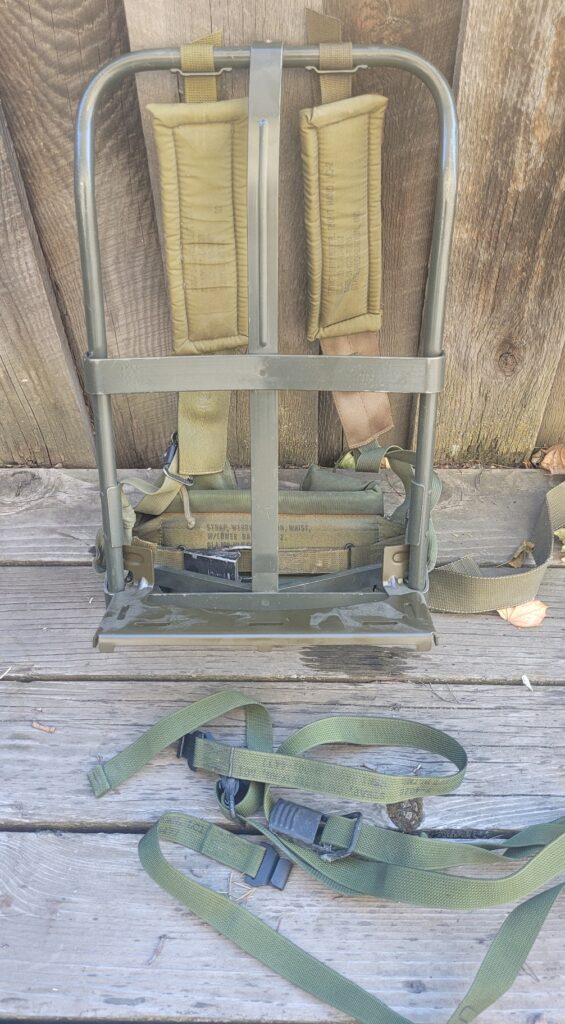 Those military-style cans, like the Scepter, are made to fit on that pack cargo shelf. You secure them with the straps and you can now carry that 40# jug of water on your back. That cargo shelf also works for cases of ammo as well.
Those military-style cans, like the Scepter, are made to fit on that pack cargo shelf. You secure them with the straps and you can now carry that 40# jug of water on your back. That cargo shelf also works for cases of ammo as well.
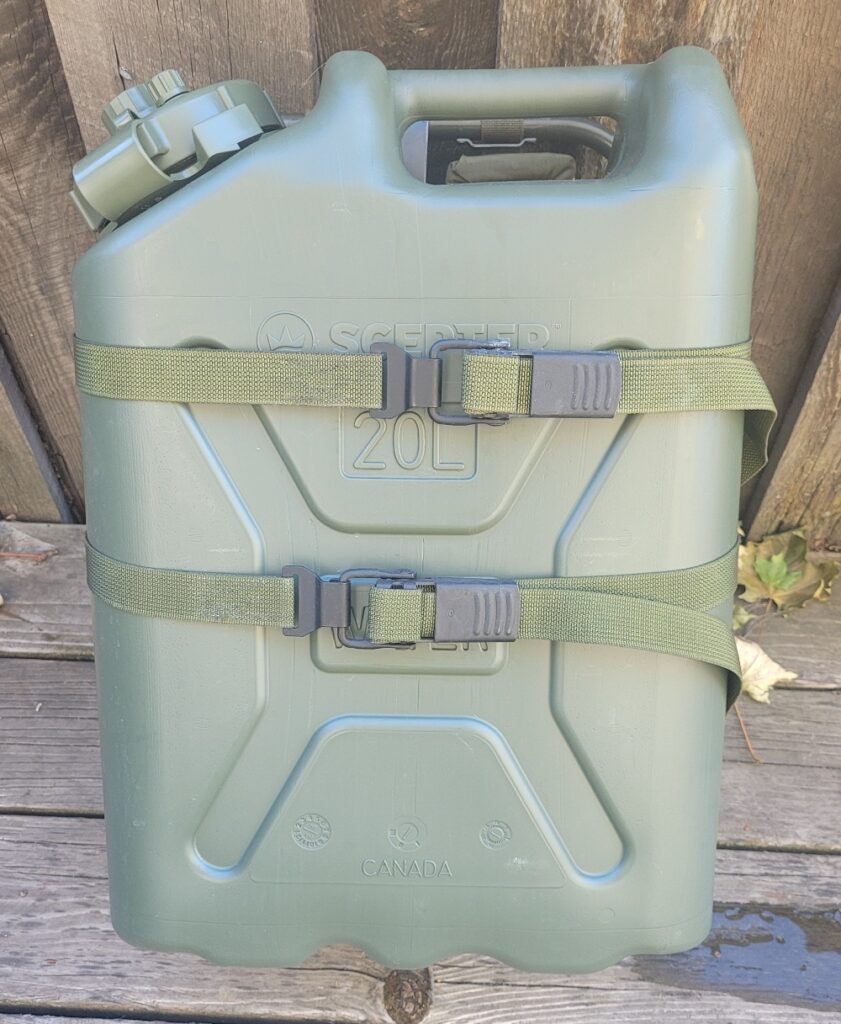 Another reason I prefer the military style water jugs is the super wide mouth on them. It makes filling and dumping easier , and it lets me reach in there to clean the darn things.
Another reason I prefer the military style water jugs is the super wide mouth on them. It makes filling and dumping easier , and it lets me reach in there to clean the darn things.
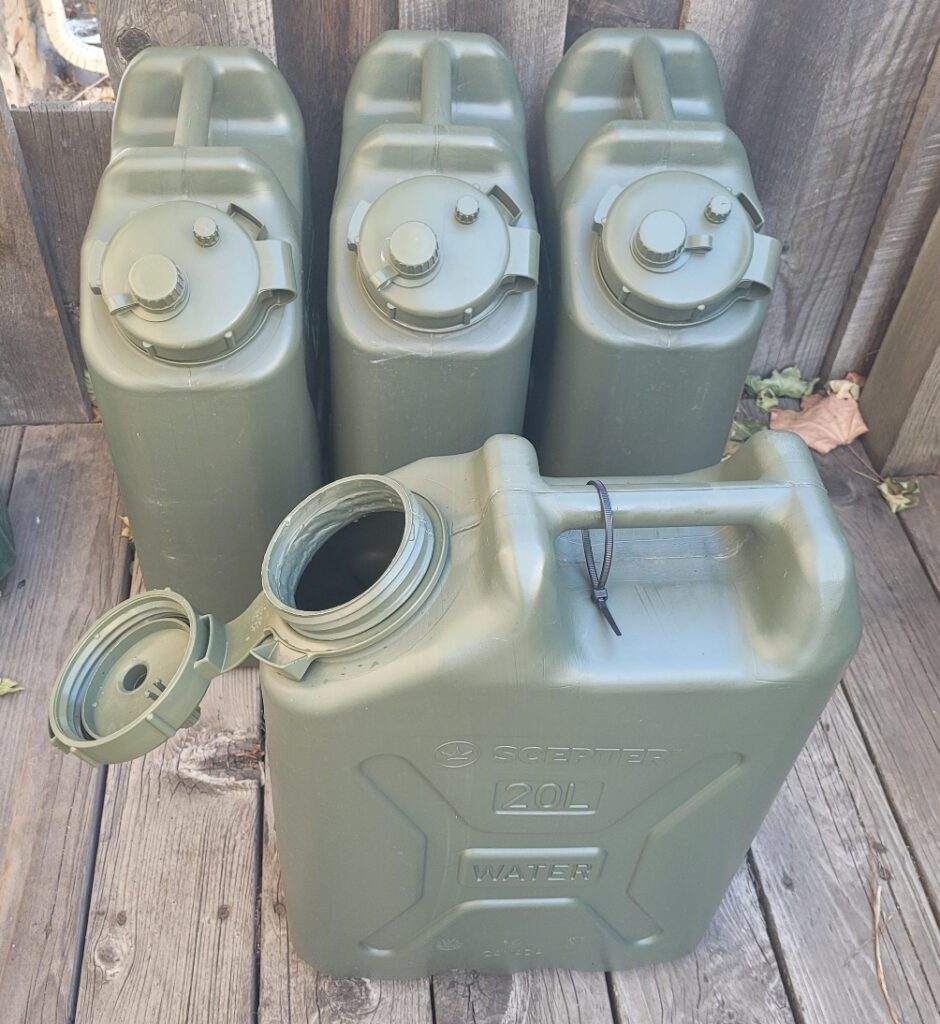 But that super wide mouth also has another advantage. Do you know what a stirrup pump is? It’s a small hand operated pump used in conjunction with a bucket of water to fight fires. They made zillions of these things in Britain during the Blitz for putting out fires after the bombing raids.
But that super wide mouth also has another advantage. Do you know what a stirrup pump is? It’s a small hand operated pump used in conjunction with a bucket of water to fight fires. They made zillions of these things in Britain during the Blitz for putting out fires after the bombing raids.
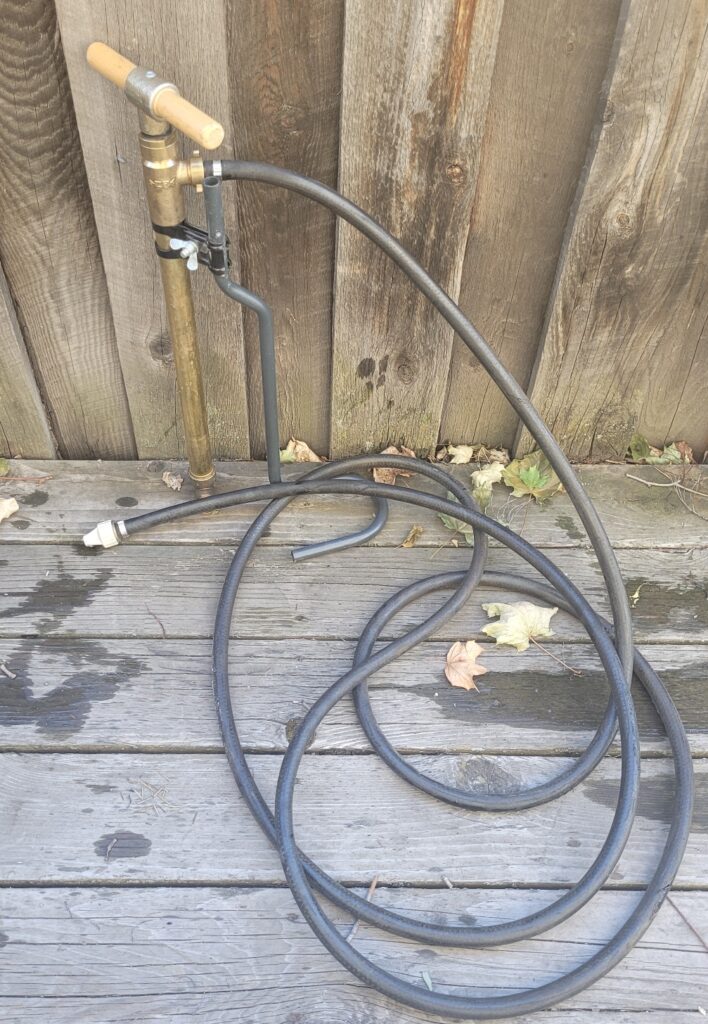 The brass part goes inside your water container, usually a bucket, and you stand on the u-shaped metal footrest. With your foot holding the pump in place, you work the handle up and down. The pump ejects water on both the downstroke and the upstroke. Range is about thirty feet or so. One person can use this but its best used as a team. Where does the jerry can come in? Glad you asked:
The brass part goes inside your water container, usually a bucket, and you stand on the u-shaped metal footrest. With your foot holding the pump in place, you work the handle up and down. The pump ejects water on both the downstroke and the upstroke. Range is about thirty feet or so. One person can use this but its best used as a team. Where does the jerry can come in? Glad you asked:
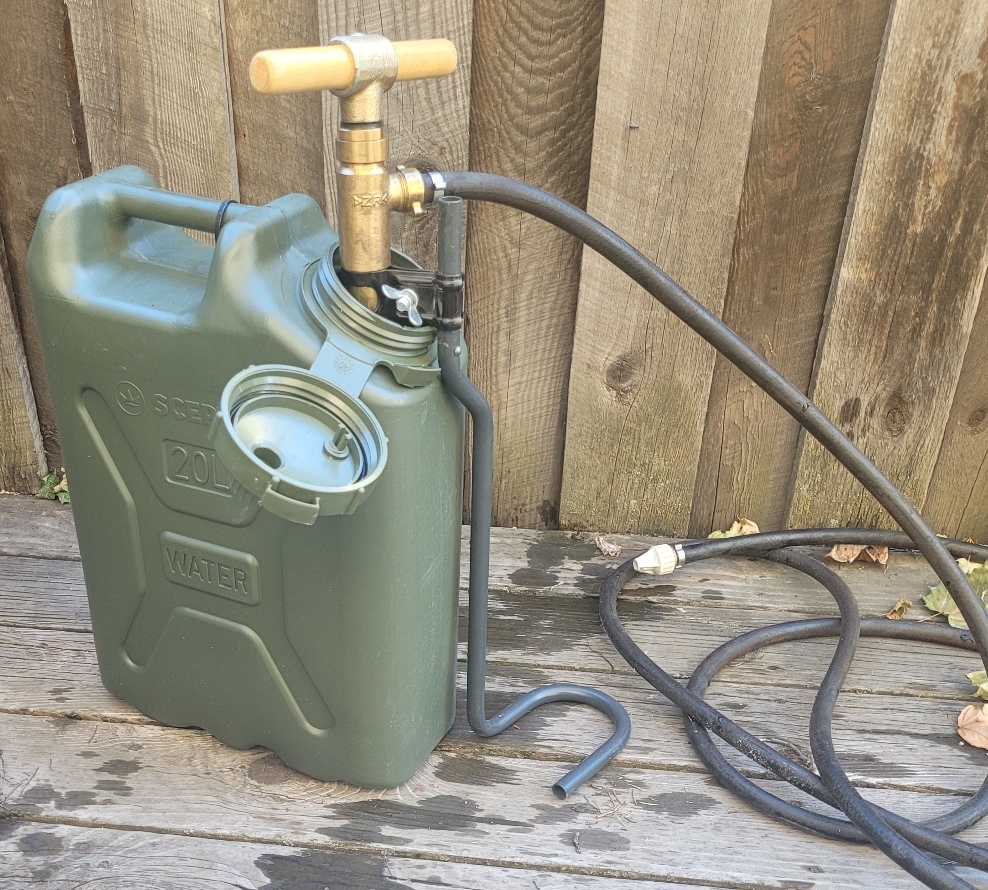 A handy way of being able to deal with small fires in a crisis. Just the ticket for small grass fires or wetting down an area ahead of a fire.
A handy way of being able to deal with small fires in a crisis. Just the ticket for small grass fires or wetting down an area ahead of a fire.
As I said, unfortunately that sort of utility doesn’t come cheap. But, for me, I’d rather spend the extra money and get something that I have confidence in and that has the portability and utility issue going for it.
On a side note, it was a nightmare getting that stupid pump. Original ones from the WW2 era are available on surplus sites and if you replace the hoses and gaskets they might work just fine. I found this thing in the catalog of a firefighting supply company and they had to import it from Germany. And I had to wait about a year and a few months to get it. Major pain in the ass, but a very nice product. Theres a blog post all about it here.

The guy at jagmte.com makes lots of useful accessories. You can get slightly lower quality cans that are US government contract at buylci.com but note the buylci website has had major issues lately and may not be online.
That pump is cool. People still don’t think about fire fighting equipment outside of a couple of fire extinguishers they’ve had for years in the closet in the preparedness community.
With the recent focus on water posts two major things I’ve done this week I’ve been putting off is to empty and refill the two 15gal water drums I keep on hand for potable water, review my water filtering/gathering methods and go buy more water jugs. Last year I bought from tacticalassaultgearstore.com and they were $29.99. Now, these are the LC Industries/Skillcraft ‘Scepter’ cans – both LCI and Scepter make water and fuel cans for the military. I’m pretty sure you did a post on them. I am also going to buy a couple more of the cheaper Reliance water jugs to use as handouts since I never got back one of the Scepter cans I let someone borrow and the jerk never even offered to replace it with anything but a “sorry”.
Great write-up sir. I seem to recall Survival Inc. or maybe The Sportsmansguide having a water pump very similar to what you pictured. i never thought to buy one.
I have several Reliance collapsible plastic bladder (5 gallon ?) as well as a pair of 5 gallon military metal gas cans and a single synthetic U.S. military water can very similar to what you have pictured (I have no idea who made it – maybe 6 -7 years old). Even have a French army interior enameled 2 gallon can supposedly for keeping wine fresh (just because its the apocalypse doesn’t mean we have to be savages … :^)
The pumps have always been the shiz…we used to cover the hoses with burlap to make “period” (i.e. non-modern-looking) water pumps for Ren Faire for water fights and such.
The pumps also fit into water buckets, stock tanks, etc.
They cannot be beaten as water movement devices without a motor that isn’t named Bubba.
And the Scepter cans?
You can accidentally drop full ones off a truck 4′ off the ground, pick them up, and empty them as designed. And then use them again afterwards.
Try that twice with that WallyWorld/Costco blue plastic camping crap.
Buy once/cry once, in action.
Oh, and btw, with those pumps, there’s no limit to how long a hose you can clamp to the brass nipple at the pump end.
Meaning you can put one on one of the steps in the shallow end of a swimming pool, and transfer water to the flush reservoir tank of a toilet 50′ away to keep it functioning when city water isn’t to be found for a week or three, which is a helluva lot easier than traipsing around with full and empty buckets.
You can even pump up to a drum reservoir in a reinforced section of attic, and get about 10 flushes for a few minutes’ work before you have to do it again.
The pump moves about a pint per stroke, roughly, assuming the seals are all tight.
😉
And if your hoses and seals are the right composition, those pumps will move other liquids besides water.
Just don’t mix POL pumps with potable water pumps, and avoid open flames.
Big Boy rules apply, and skin grafts from burns are painful.
To recently quote a famous Internet Raconteur, “If you’re going to take a whack at derpsplaining things on the Internet that are clearly beyond your basic grasp, maybe – just spitballing, mind you – some folks should pull back on their heads first until they hear a loud popping noise, and it suddenly gets brighter and easier to breathe.”
Stirrup pumps are amazing examples of western civ engineering prowess, but they are not magical fluid transport devices. To ignorantly state that “with those pumps, there’s no limit to how long a hose you can clamp to the brass nipple at the pump end.” is to boldly shove shite information down the throat of an innocent Internet. Unless you can confidently turn to the proper page on your well worn hardcopy of Cameron Hydraulic Data and explain why using a stirrup pump to move water 50′ and uphill to an attic reservoir is an exercise in futility and frustration, perhaps fluid engineering is a bit beyond your abilities and should be kept quietly to yourself.
Catty and unworthy of you.
But also funny as all get out. You should publish a collection of your sniping. Well done, sir, well done!
I once wrote about 30 parody comments on an article protesting the Yulin Dog Festival (which celebrates eating dog meat). Some of those comments were the best comedy writing I’ve ever done. Wish I could find the link again…
The only problem with that brilliant riposte is that it’s actually been done. Within my sight.
And last I looked, pumps are, in point of fact, “fluid transport devices”. You could look it up. I don’t believe any magic is involved, unless it’s in a Terry Pratchett novel.
Provided you’re not trying to pump upwards over 33 feet, going back to the middle ages. There are even German mining manuals dating to about five minutes after Gutenberg invented the printing press detailing how to do it.
I guess no one told them you’d disproven their efforts either.
Maybe tell the class how hand pumps seen nationwide for centuries before electricity, sited at ground level can’t extract water from wells and subterranean cisterns either. I can’t wait to read that one.
https://en.wikipedia.org/wiki/Mining_and_metallurgy_in_medieval_Europe
With a handle like SilverMiner, you should have known that. (Unless you just collect change at laundromats, in which case, I apologize.)
So yeah, for the derp-impaired, if your attic is 4 stories up, rather than immediately above the ground floor, you’re not going to get ‘er done.
Maybe you graduated from the school of engineering that determined that it’s similarly impossible for bumblebees to fly?
But I give you an “A” for effort, and a “D” for accuracy.
Reality tends to weight the “accuracy” part heavier than the “effort” part. Sorry about that.
And I always love when people tell me that things that have been done for 600+ years are impossible, because science.
here’s something to help you out, which took about two mouseclicks to find:
“How far can a pump push water vertically?”
“There is no limit —-
A cubic inch of water weighs about .5784 oz. at sea level. The pressure exerted by a column of water 1 inch square and 1 foot tall is 12 times that weight or 6.94 oz per square inch. Dividing by 16 this is equivalent to .434 psi. So each .434 psi of pressure from a pump will be able to pump water up one foot. If you have a pump that will produce 100 psi, it will pump water up (100/.434) = 250.5 feet. There is really no limit to how high the water can be pumped. The limit is only in how much pressure you can get from a pump and whether you have a pipe that can handle that much pressure.
Said another way:
Take height in feet to be pumped and multiply by .434 to get pressure needed
or
Take pressure in psi and divide by .434 to get the height it will pump
This analysis is accurate for all practical applications, but does fall apart theoretically when the elevation becomes so large that the reduced gravitational force comes into play. I wouldn’t be too concerned about the impact of this. At a pumping altitude of 500 kilometers this would result in less than a 2.5% difference in required pressure. Getting a pipe to stand up 500 km tall would however be problematic! ;-)”
https://physicsfatcz.quora.com/How-far-can-a-pump-push-water-vertically#:~:text=up%20one%20foot.-,If%20you%20have%20a%20pump%20that%20will%20produce%20100%20psi,can%20handle%20that%20much%20pressure.
The school I learned math in says that I can get water from a hand pump generating a blistering 5 psi can get water 11.5′ ft above me. I’ll throw you a bone and call it only 10′, with friction loss, through a garden hose. Even a low-pressure municipal hose line runs 40-60 psi, and I can get that much pressure out of a decent hand pump like the one in the OP. But let’s allow for stroke time and getting tired, and say we only get 10 psi out of it, on average.
That’s a 23′ lift. Call it 20′, after pushing it 30 feet horizontally through a garden hose.
Is your attic on top of a fire tower?
Your move.
“…it’s actually been done. Within my sight.”
What a sad and pathetic lie. I can only imagine your sole defense would be ‘well that’s what I thought I saw’.
Fortunately, there is a very easy solution. Rather than me wasting time attempting to teach a pig to sing (RAH wisely advised against it), you have the power to resolve this simply and conclusively. Merely film yourself or another using a stirrup pump to empty one five gallon bucket into another five gallon bucket placed atop a 10′ step ladder using a fifty foot hose. Post the video to YouTube or your blog, laugh maniacally and then do your best Galileo impression while stating “And yet it flows”.
Considerable cash is now riding on whatever path you choose. 5 men good and true convened yesterday evening to mock, deride, and howl with laughter over your arrogant ignorance so publicly and proudly displayed. Each have placed all possible wagers and side bets anticipating your next move. I myself believe I will soon come into a tidy sum regardless of what decision you next make.
So go on, do it. Fly, bumblebee, FLY – no matter what French entomoligists, not engineers say! As per the wagers, I can influence this circus no longer.
I was thinking along the same lines.
When it’s over, remember you asked for this.
How it used to be [still today] – https://youtu.be/hzFdvnE8v0Y?si=Kvd7vMVxU12F2eEC&t=47
Can I Introduce you to an equine stomach pump….similar available at any farm store: https://www.allvetsupply.com/sheqstpu.html?cmp=googleproducts&kw=sheqstpu&gad_source=1&gbraid=0AAAAAD-qFG147cosfW930BrAHZdztlkgx&gclid=CjwKCAjw5Ky1BhAgEiwA5jGujoVrZPFmJfLSiIl2VfHOyJMQk1zPRSyMv1FQCzhytsbqR7erFGboqhoC9FMQAvD_BwE
Looks almost the same but not made for the volume or the power.
The Sceptre USGI water cans are built like M1 Abrams tanks…very durable and also very expensive. They offer lookalikes that are less expensive, and unfortunately less durable. Know what you’re buying: The wall thickness on the GI cans is about 1/8 inch. I’ve seen them run over by M1 Abrams tanks, and while the cap will blow off they rarely sustain any other damage. It’s really impressive they are that soldier proof.
Likewise their fuel cans: GI are much heavier than civvy, more expensive, hard to find in the US (I sneak off to Canaduh and buy them there), but they are the real deal. Cost is about the same as the NATO metal cans which I also have.
For fuel, you can get various colored caps and straps if you want to code your product in some way. I use red straps for gasoline, yellow for kerosene and leave the original for diesel. They also have suction and gravity feed adapters, hand wash / drinking adapters and a few other goodies. They used to market a tray that would hold 5 cans and contain any spillage but I don’t see them now
https://www.scepter.com/products/military-products/
I use the water cubes (7 gallons each) at home for my last chance water supply. With a well, and Flathead Lake, I don’t need to worry much but those cans stack very neatly, and I use the water to clean out the sump in my basement every year and then refill them.
It used be easy to get milsurplus equipment around my area. Till the stores all closed up. Now the closet store to my area is a two hour drive to Grand Rapids. After that it’s another hour to Clare.
So I shop by catalogs or online. What with the huge increase in shipping even at sale prices you don’t save that much. One alternative is to hit some of the big gun shows in Louisville Kentucky. They have several surplus dealers there. They have 4 per year at the State Fairgrounds. They have about 5000 tables with roughly half being equipment/field gear. The rest guns and ammo.
But I do miss the days when every small town had at least one surplus store.
BTW: Please don’t ask me how I know but those blue water cubes you mentioned are VERY not durable – especially they’re not even a little bit UV-resistant.